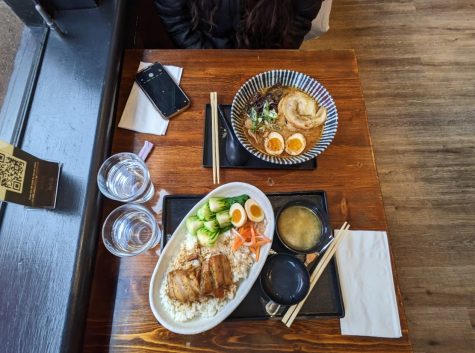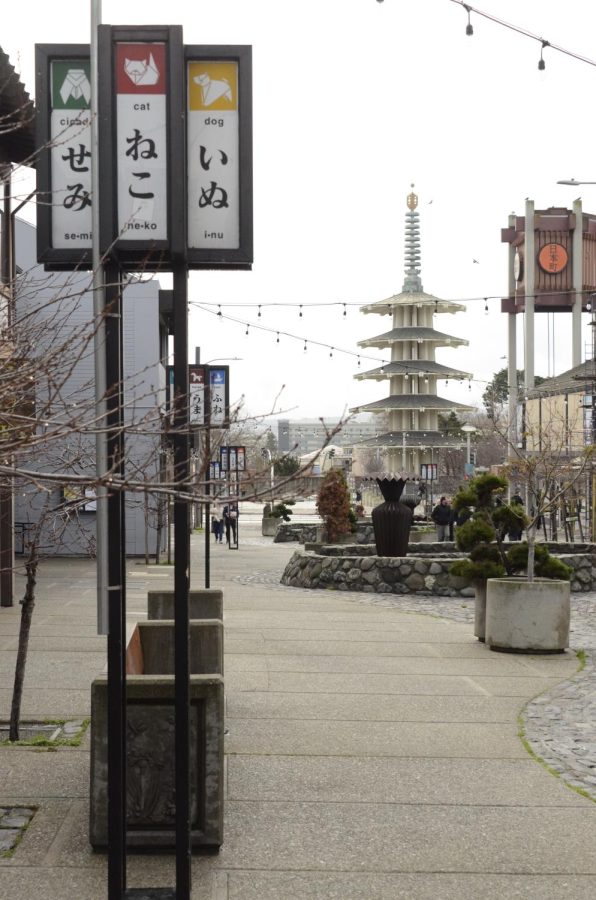Out of the nest: A day in Japantown, San Francisco
At the center of Japantown towers the five-story concrete Peace Pagoda. The Buddhist stupa was a gift from the former sister city of Osaka, Japan and now serves as an iconic landmark and gathering spot of Japantown.
San Francisco’s Japantown, or “Nihonmachi,” boasts a wealth of delicious restaurants, family-owned businesses and vestiges of the hidden history of the Japanese-American community. Despite the once 40-block long ethnic enclave being distilled to a six block area after the horrors of Japanese-American internment during World War II, the neighborhood, which was first established in the late 1900s, remains a vibrant, defiant celebration of Japanese culture and a cornerstone of the Japanese-American community in the Bay Area. Easily accessible either by car or a combination of the Caltrain and the Muni, a day trip to this historically and culturally rich district proves enriching.
At the center of Japantown towers the five-story concrete Peace Pagoda. Situated between Post and Geary streets, the Buddhist shrine serves as a visual anchor from blocks away. A gift from San Francisco’s former sister city Osaka in 1968, the stupa lends calm to the bustling plaza. The San Francisco Peace Pagoda’s design is inspired by the Million Pagoda, a design first introduced in miniatures by Empress Koken in 770.
Though largely deserted in the dreary early morning, Peace Plaza fills as lunch approaches. The southern end of the plaza is an elevated area filled with visitors crossing between malls and taking pictures with the pagoda. Large bronze statues chronicle the history of Japantown and Japanese immigrants in the Bay Area. When we visited, an elderly man was playing his flute in the Plaza. Surrounded by a crowd of admirers and situated between the statues and semicircle seating areas, the scene couldn’t help but be picturesque. With a mochi donut and good company, it’s easy to spend an afternoon basking in the presence of strangers.
A literal and figurative pillar of the community, the Peace Pagoda hosts various community celebrations throughout the year. The near 60-years-old annual San Francisco Cherry Blossom Festival will take place on the weekends of April 8 to April 9 and April 15 to April 16. Local businesses host activities like taiko drum performances, the Chanoyu tea ceremony and a karate showcase from World Oyama Karate, among others. Amidst the pink petals, each weekend closes with a boisterous parade through the center of Japantown.
The Nihonmachi Street Fair, which usually occurs in early August and was first held in 1974, showcases both cultural performances and modern musical acts, with each performer hailing from a variety of Asian American and Pacific Islander (AAPI) backgrounds. In 2022, the Parangal Dance Company performed a Filipino folk dance, Gamelan Sekar Jaya presented a Balinese dance and the Samoan Community Development Center’s Samoan Warriors wowed with a performance from their Tupulaga Talavou Tula’i program, a group of Pacific Islander youth from around the Bay Area. San Francisco Taiko Dojo has participated in the celebration every year since its inception. A variety of delicious street food stands and artisanal vendors selling handmade Japanese crafts accompany the rich entertainment. Recently, framed against the spike in anti-Asian racism witnessed throughout the coronavirus pandemic, the festival adopted the theme of a “Summer of Love,” taking a stand against the pernicious sentiments attacking the AAPI community.

Tasty eats are available at all times of the year, with many sit-down and take-away restaurants offering different styles of Japanese cuisine. One of several stops at Buchanan Mall, a pedestrian-only boulevard home to many of Japantown’s iconic businesses, the Hoshinoya restaurant offers a wide variety of many popular Japanese dishes. Wide windows offer the bustle of the street as entertainment, especially when seated in the prime people-watching tables along the wall.
Hoshinoya serves popular small plates like “agedashi” tofu, warm fried tofu with “dashi” broth or chicken “karaage,” a very lightly-floured type of fried chicken. For a more filling option, try the “kurobuta kakuni” bowl, which consists of buttery-soft braised pork belly on fluffy white rice, or the “tonkotsu” ramen, which is a steaming, comforting soup made of thin noodles, a bone-based broth and various toppings, like “kikurage” mushrooms, “menma” fermented bamboo shoots or a soft-boiled egg. One of their most popular options is the “gyukotsu,” which combines braised short rib with traditional tonkotsu broth. However, orders of this dish are limited to 15 per day because of the overnight braising of the short rib.
Hoshinoya, “place of stars,” offers a gastronomical glimpse into owner Nuttawat Wongpisethkul’s international upbringing. Wongpisethkul previously owned Osha Thai, a long standing pillar of Bay Area Thai food, but together with his girlfriend, Stella, who lived and studied with a host family in Japan, decided to go in a different direction and explore the diverse and dimensional Japanese cuisine. Originally a test kitchen called Hoshi Ramen and Rice, Hoshinoya opened just as the pandemic began in March 2020.
Thai influences are not apparent in Hoshinoya’s comforting lineup of Japanese meals, but Wongpisethkul’s experience in the restaurant business is. After studying Japanese culture and cuisine, he deftfully creates authentic, mouth-watering dishes yet maintains the coziness of a home-cooked meal. Pop into Hoshinoya for an easy and well priced lunchtime start or dinnertime end to your Japantown trip. Piping hot and neatly garnished with corn, shredded pickles, bamboo shoots, green onions and more, the dishes are sure to satisfy.
Tucked in the southeastern edge of the Buchanan Mall is one of the oldest legacy stores in Japantown. Giant floor to ceiling windows showcase a display overflowing with origami hearts. Paper Tree, run by the Mihara family since 1968, boasts a collection of intricate origami pieces, the glass cases guiding visitors into the rest of the store.
The store features work from origami artists around the world, a group which includes the shop’s current manager, Linda Mihara. A breathtaking eastern dragon made of an uncut six-foot square of paper, twisting in its clear case and covered in tapered scales, designed by Satoshi Kamiya and folded by Richard Cam, currently sits front and center. “Koinobori,” colorful carp kites traditionally made from cloth or paper, hang on the wall.
Turning right into the rest of the store, a fat stone monk greets visitors, decked out in an origami kimono and mask and clutching a pride flag. Behind him is a bursting display of various origami papers, along with guide books for all levels. Moving deeper into the store, the usual stationery paraphernalia makes an appearance: socks, pens and erasers shaped into as many foods as offered in the malls.
After passing the giant shelf overflowing with plushies marking the midpoint of the store, Paper Tree takes on a more luxurious feel. Giant silk screen prints cover the walls, the gold ink warmly reflecting the sunlight from the windows. From racks hang large sheets of paper, much of it “washi,” handmade mulberry paper, imported from Japan. However, Paper Tree also carries papers from Thailand, Italy and Nepal. By the checkout counter is a set of handmade cards and “shugi-bukuro” envelopes, used to gift money. The checkout counter also is where one of the hallmark services of Paper Tree takes place: gift wrapping, a showcase of the store’s products and talent.
Paper Tree prices vary greatly depending on the product, but products were generally priced slightly below those in other stationery stores we visited in the area, like Maido. The store carries something for every visitor, whether they are an expert seeking massive sheets of paper or a beginner off the street lured in by the colorful window display. Even if stationery does not interest you, the rich history and cozy interior of Paper Tree make a visit to the store worthwhile.
In 1925, Masayasu and Naka Ashizawa founded Soko Hardware Store, passing down the now-iconic store down from generation to generation. Japanese houseware and art live on the first floor. The lower level, accessible via a wide wooden staircase, is filled with paint samples, fishing gear, doorknobs and more. Furthermore, the store, whose name is the word for San Francisco used by the first wave of Japanese immigrants, carries Japanese knives, teapots, woodworking tools and “Butsudans,” small Buddhist Shrines for temples and homes. Even with no knowledge about hardware, our time bumbling around Soko Hardware perusing the assorted goods was a pleasant break from the cloudy outside.
To cap off the day, if you’re craving something sweet look no further than Mochill Mochi Donuts. Located in the West Mall, this shop offers freshly-made mochi donuts in a variety of flavors, from matcha to black sesame to mango. Unlike the typical American-style donut, mochi donuts are made with glutinous rice flour, giving them a unique airy, chewy texture. For a more savory snack option, Mochill’s sister-company Takoyaki Yama-Chan is right next-door. Takoyaki is a popular street food in Japan and is made by combining octopus and wheat flour and grilling the mixture in a specially-made ball-shaped griddle.

Katerina Matta (12) is an Editor-in-Chief of the Winged Post, and this is her fourth year on staff. This year, she looks forward to experimenting with...

Alison Yang (12) is an Editor-in-Chief of Harker Aquila, and this is her fourth year on staff. This year, she looks forward to bonding with everyone on...


















![“[Building nerf blasters] became this outlet of creativity for me that hasn't been matched by anything else. The process [of] making a build complete to your desire is such a painstakingly difficult process, but I've had to learn from [the skills needed from] soldering to proper painting. There's so many different options for everything, if you think about it, it exists. The best part is [that] if it doesn't exist, you can build it yourself," Ishaan Parate said.](https://harkeraquila.com/wp-content/uploads/2022/08/DSC_8149-900x604.jpg)




![“When I came into high school, I was ready to be a follower. But DECA was a game changer for me. It helped me overcome my fear of public speaking, and it's played such a major role in who I've become today. To be able to successfully lead a chapter of 150 students, an officer team and be one of the upperclassmen I once really admired is something I'm [really] proud of,” Anvitha Tummala ('21) said.](https://harkeraquila.com/wp-content/uploads/2021/07/Screen-Shot-2021-07-25-at-9.50.05-AM-900x594.png)







![“I think getting up in the morning and having a sense of purpose [is exciting]. I think without a certain amount of drive, life is kind of obsolete and mundane, and I think having that every single day is what makes each day unique and kind of makes life exciting,” Neymika Jain (12) said.](https://harkeraquila.com/wp-content/uploads/2017/06/Screen-Shot-2017-06-03-at-4.54.16-PM.png)








![“My slogan is ‘slow feet, don’t eat, and I’m hungry.’ You need to run fast to get where you are–you aren't going to get those championships if you aren't fast,” Angel Cervantes (12) said. “I want to do well in school on my tests and in track and win championships for my team. I live by that, [and] I can do that anywhere: in the classroom or on the field.”](https://harkeraquila.com/wp-content/uploads/2018/06/DSC5146-900x601.jpg)
![“[Volleyball has] taught me how to fall correctly, and another thing it taught is that you don’t have to be the best at something to be good at it. If you just hit the ball in a smart way, then it still scores points and you’re good at it. You could be a background player and still make a much bigger impact on the team than you would think,” Anya Gert (’20) said.](https://harkeraquila.com/wp-content/uploads/2020/06/AnnaGert_JinTuan_HoHPhotoEdited-600x900.jpeg)

![“I'm not nearly there yet, but [my confidence has] definitely been getting better since I was pretty shy and timid coming into Harker my freshman year. I know that there's a lot of people that are really confident in what they do, and I really admire them. Everyone's so driven and that has really pushed me to kind of try to find my own place in high school and be more confident,” Alyssa Huang (’20) said.](https://harkeraquila.com/wp-content/uploads/2020/06/AlyssaHuang_EmilyChen_HoHPhoto-900x749.jpeg)




